Haydar Pasha, Nicosia
| Haydar Pasha | |
|---|---|
| Haydarpaşa, Χαϊδάρ Πασά | |
 Haydar Pasha Location in Cyprus | |
| Coordinates: 35°10′39″N 33°21′58″E / 35.17750°N 33.36611°ECoordinates: 35°10′39″N 33°21′58″E / 35.17750°N 33.36611°E | |
| Country |
|
| District | Nicosia District |
| Municipality | Nicosia |
| Population (2011) | |
| • Total | 155 |
| Time zone | EET (UTC+2) |
| • Summer (DST) | EEST (UTC+3) |
Haydar Pasha (Turkish: Haydarpaşa, Greek: Χαϊδάρ Πασά) is a Neighbourhood, Quarter or Mahalle of Nicosia, Cyprus[1][2][3] and the mosque situated therein. Both are named after Haydar Pasha, said to be one of the 12 generals in command of divisions of the Ottoman army at the time of the Ottoman conquest of Nicosia. Each general being posted to a quarter, that quarter was known by his name.[4]
At the last Census (2011) it had a population of 155.[5] In 1946 it had a population of 385 (Turkish 334, Greek 45).[6]
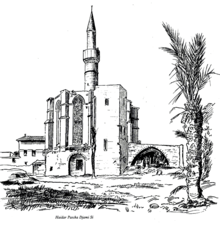
History
Haydar Pasha is one of the 24 historic Neighbourhoods of Nicosia within the walls.[2] It was one of the 12 Neighbourhoods into which Nicosia was divided at the Ottoman conquest in 1570[4]
Before 1570 Haydar Pasha mosque was a church of the Latin community dedicated to St. Catherine.[8] It was built towards the end of the 14th Century. Except for the low windows pierced at floor level in the walls and the minaret erected by the Turks, it is changed little from the day it was built.[9]
Haydar Pasha Mosque
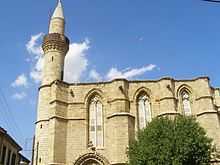
Haydar Pasha is the most important Gothic building in Nicosia after Ayia Sophia, formerly the Frankish (Latin) cathedral of Nicosia.[9] It has been described by Harry Charles Luke as representing one of the finest examples of Gothic building on the island.
Other landmarks
Lapidary Museum
Just south of Haydar Pasha mosque is the famous Lapidary Museum[10] housed in a 15th Century house. The first floor is lighted with square windows, which have balconies supported on carved corbels, each decorated with a device. This house now contains medieval and Gothic fragments from vanished palaces and churches of Nicosia. The great window in the north wall is from the Lusignan royal palace that stood in Sarayonu Square, until 1904. This arched window is all that remains of the royal palace. Here too is preserved the tomb of Adam of Antioch, Marshall of Cyprus, which was found when the Church of Pallouriotissa was being rebuilt.[9]
The building is in the style of the early Venetian Renaissance and thus may pre-date the Venetian occupation of Cyprus. It is an almost unique example of this style in the island.[4]
Lusignan House
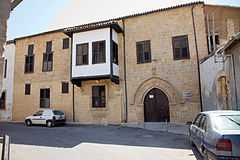
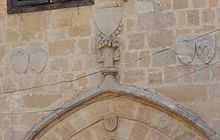
Just to the north of Haydar Pasha mosque is the Lusignan House Museum. Situated in Yeni Jami Street, this 15th century house has an impressive Gothic arch above which are several coats of arms[11] In 1958, the mansion, which had been used by the Russian Classen family as residence and a weaving workshop, was bequeathed by them to the Cyprus Government. However it was not opened to the public until 1997.
The oldest part of the house is the exterior as the interior was repeatedly rebuilt in Ottomans times. The doorway is a pointed arch with moulded voussures under an elaborate hood mould, which terminates in a well preserved crocketed finial supporting the shield of the Royal Arms of Cyprus (namely of the Lusignan kings), although this shield is defaced or damaged. On either side of this shield are two pairs of smaller shields, each pair bracketed together. The right-most of these is in better condition and bears the common Italian design "Ondato" (i.e. waves). Within the apex of the arch is a smaller shield, probably of the house of Dampierre.[4]
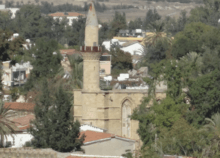
References
- ↑ "Population Enumerated by Sex, Age, District, Municipality/Community and Quarter, 2011 – (2011 Census of the Republic of Cyprus, Statistical Service)" (in (Greek)). Mof.gov.cy. Retrieved 2012-07-21
- ↑ 2.0 2.1 Coexistence in the Disappeared Mixed Neighbourhoods of Nicosia by Ahmet An (Paper read at the conference: Nicosia: The Last Divided Capital in Europe, organized by the London Metropolitan University on 20th June 2011)
- ↑ 6th edition of the publication “Statistical Codes of Municipalities, Communities and Quarters of Cyprus” (publ. Statistical Service of Republic of Cyprus)
- ↑ 4.0 4.1 4.2 4.3 A description of the historic monuments of Cyprus. Studies in the archaeology and architecture of the island, by George Jeffery, Architect, 1918
- ↑ Census organised by the Turkish Cypriots in the occupied area http://www.devplan.org/Nufus-2011/nufus%20ikinci_.pdf retrieved October 2013
- ↑ Census of Cyprus, 1946
- ↑ Mahallas,Nicosia Turkish Municipality http://www.lefkosabelediyesi.org/tr/index.php/lefkosa/resmi-kurumlar/muhtarl-klar retrieved Oct 2013
- ↑ Levkosia, the capital of Cyprus" by Archduke Louis Salvator, 1881
- ↑ 9.0 9.1 9.2 "Historic Cyprus - A Guide to its Towns and Villages, Monasteries and Castles", by Rupert Gunnis (former Inspector of Antiquities in Cyprus), pub 1936, reprinted 1973 by Halkin Sesh Ltd, Nicosia. Pp 58-60
- ↑ Listed as one of the 11 main attractions of Nicosia in "Romantic Cyprus", by Kevork Keshishian, 1958 edition
- ↑ See http://www.allcrusades.com retrieved Oct 2013
| ||||||||||